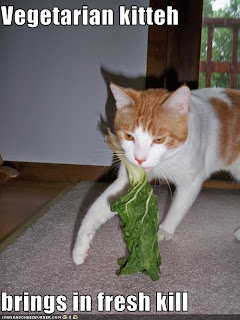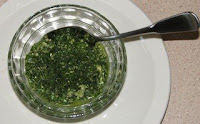Tuesday, July 28, 2009
Week 7: The Hyper-Local Dinner
THIS WEEK'S HIT: Dinner with friends. HONORABLE MENTION: Deconstructed Squash "Salad"
Kit went off to overnight camp this week. This will not appreciably change the amount of vegetables consumed at home, or at camp, I suspect.
It's not that Kit dislikes vegetables. She dislikes risk, which makes her leery of any food presented in a novel way. Our CSA program throws her for a loop, because I tend to experiment with the vegetables we receive.
One favorite of hers, though, is corn. And that was our modest contribution to an amazing meal we had with friends a couple of days before Kit's departure to camp. Our hosts' game plan: Visit a local farmers' market for fish and vegetables and make dinner from the purchases.
Now you should know that our friends, in addition to being great cooks, are kitchen maniacs who do not restrict themselves to the model of Entree-Starch-Vegetable. So our meal -- for four adults and three children -- included striped bass and salmon from a local fish purveyor; yellow squash grilled with a homemade mocha spice mix (yup, there's a local chocolate manufacturer); grilled celeriac; collards cooked with shallots and veggie bacon; two kinds of potato salad; pickled beets and other pickled vegetables; grilled chicken cutlets; a savory plum sauce for the grilled food; wild blueberry-custard tarts; chocolate angel food cake with black raspberry sauce (raspberries from the hosts' garden!); brownies with chocolate chips and marshmallows; and the boiled corn. Just about everything served, aside from the brownies, featured a local ingredient. And I'm probably forgetting something we ate.
It would be daunting to replicate that meal, but the components came from Connors Farm (our CSA!), the Winchester Farmers Market, and the Arlington Farmers Market. There are numerous other farmers' markets in the Boston area; Taza Chocolate makes the rounds at several of them.
Back at home, we kept things simple. We mixed our CSA tomatoes and cucumbers with onion for a cool chopped salad; marinated chickpeas and more cucumber in basalmic vinegar and olive oil; and munched on peaches and sweet, raw carrots. We also fiddled with a recipe for a sauteed squash salad, cutting down on the olive oil and serving the components separately to accommodate individual tastes. The original recipe was posted on the Idylwilde Farm web site; my version is below. (Sorry, no picture. We ate this up too quickly.)
Deconstructed Squash "Salad"
Ingredients
2 small zucchini
2 small yellow squash
4 cloves garlic
2 Tbsp olive oil
Balsamic vinegar
Hot pepper flakes
salt and pepper
Peel and slice the garlic. Remove the ends of the squash and slice lengthwise into 1/4-inch slices. Cut the slices in half crosswise if they are very long.
Heat the olive oil in a large skillet and saute the garlic slices until they are brown. Remove and reserve the garlic. Saute the squash slices in batches until brown, about 2 minutes per side. If necessary, drain the slices on paper towels before placing on a platter.
Serve the squash at room temperature with the garlic slices, vinegar, and spices available on the side. Serves 2 to 4 people.
Thursday, July 23, 2009
Cat got your chard?

My older daughter found this posted at the Lolcats site. She tells me CSA stands for "Cat-supported Agriculture."
Week 6: Weather or Not
THIS WEEK’S HIT: Nut-Free Pesto
See those flowers over there in the photo? That’s our farm’s way of saying “We’re sorry about June.”

If you didn’t experience our June, you probably heard about it. Cloudy. Chilly. Wet. Repeat. Good weather for growing lettuce and other greens, apparently; kind of hard on the other crops.
The weather improved a bit recently, and the CSA bag that we picked up on July 17 was light, but it had new things:
1 bunch basil; 1 pint blueberries; 6 ears corn; 1/2 pound green beans; 1 bunch kale; 1 huge head Boston lettuce; and 3 summer squash. The hanging bag of impatiens was the perk.Now it happens that we picked up our first-ever CSA basket just a year ago, on July 18, 2008, so we can compare weeks:
1 bunch basil; 1 pint blueberries; 12 ears corn; 13 pickling cucumbers; 4 regular cucumbers; 1 bunch dill; 2 pounds green beans; 2 heads red leaf lettuce; 1 head romaine lettuce; 4 spring onions; 3 pattypan squash; 1 pint raspberries; 3 summer squash; 2 bunches Swiss chard; and 10 zucchini.That turned out to be a representative week for the summer. See what a little sunshine can do around here?
We kept the vegetables mostly plain this week – boiled corn, steamed beans, sauteed kale. The summer squash were sliced, sauteed with onions and garlic, and then simmered with a homemade tomato sauce. I served them with pasta and a nice dollop of basil pesto.
 Because I can’t use nuts in my cooking, I use this pesto recipe, modified from one printed some years back in The Boston Globe. You can freeze the basil puree, without the cheese, in ice cube trays. Just add some cheese after defrosting. I sometimes throw a cube of this into soup or stew.
Because I can’t use nuts in my cooking, I use this pesto recipe, modified from one printed some years back in The Boston Globe. You can freeze the basil puree, without the cheese, in ice cube trays. Just add some cheese after defrosting. I sometimes throw a cube of this into soup or stew.Nut-Free Pesto
(makes about 1.5 cups)
Ingredients
1 clove garlic, or more to taste
1/2 teaspoon salt
5 cups packed fresh basil leaves
1/2 cup olive oil, or less to taste
1/2 cup grated Parmesan cheese
Directions
In a food processor, combine the garlic and salt and pulse to chop. Add the basil and oil. Pulse the mixture until it is finely pureed but is not a smooth paste.
Transfer the mixture to a bowl. Taste for seasoning and add more chopped garlic if desired. If using immediately, stir in the cheese. Otherwise, cover the pesto tightly and refrigerate. Add the cheese just before serving.
Thursday, July 16, 2009
Week 5: A Quick CSA Primer
THIS WEEK’S HITS: Vegetarian “Cajun” Collards and Chard, Chickpeas and Feta
Broadly speaking, Community Supported Agriculture is a system of shared risk. You pay in advance for a share of the harvest and you assume some of the farmer’s risks in growing it.
There are different models for this. Some CSA programs are run by a single farm; others are cooperatives. Some operate in an Iron Chef mode: Your bag of “secret ingredients” is revealed each week. Others offer credits or “free choice” so you can bag your own mix of produce from the available harvest. Still others require members to work on the farm as part of their share.
What’s available from a CSA, in terms of quantity and variety, can vary considerably, depending on weather, critters, Acts of God, and the farm’s commitments to retail outlets. It’s not necessarily a money-saver -- though I certainly squirreled away a lot of food last fall. It’s more about eating well and supporting local agriculture.
I love our CSA program, and it’s a good fit for us. It helps that The Programmer and I like vegetables, like to cook, and are willing to experiment with unfamiliar food. I know where my vegetables are being grown and I know the guy who’s growing them.
That’s a benefit also offered by farmers’ markets and farm stands. If a CSA share is not a practical option for you (and you know who you are), I encourage you to patronize your local growers for fresh, seasonal produce. Local food is good eating!
 The past week was a light one for our CSA, which is still recovering from a gloomy June. We received Swiss chard, beets, Boston and red leaf lettuce, collard greens, sage plants for our own garden, and a voucher for pick-your-own fruit later this season. Still, it was a good week of dinners. Chard, Chickpeas and Feta was a side dish to baked cod. Several recipes are available on the Web; I started with the one here, substituting red onion for green. I pickled the beets in a mustard vinaigrette and I roasted chicken with parsley, thyme, and our newly acquired sage.
The past week was a light one for our CSA, which is still recovering from a gloomy June. We received Swiss chard, beets, Boston and red leaf lettuce, collard greens, sage plants for our own garden, and a voucher for pick-your-own fruit later this season. Still, it was a good week of dinners. Chard, Chickpeas and Feta was a side dish to baked cod. Several recipes are available on the Web; I started with the one here, substituting red onion for green. I pickled the beets in a mustard vinaigrette and I roasted chicken with parsley, thyme, and our newly acquired sage.Colla
 rd greens were a new one for us. (Yes, The Programmer grew up in Florida, but his Miami upbringing was closer in spirit to New York than anywhere in the Deep South.)
rd greens were a new one for us. (Yes, The Programmer grew up in Florida, but his Miami upbringing was closer in spirit to New York than anywhere in the Deep South.)Unlike many traditional recipes for collards, this one – slightly modified from one found on About.com -- includes no pork and has a fairly short cooking time. I served the greens with the roasted chicken. They were even better reheated the next day.
Vegetarian “Cajun” Collards
Ingredients
1 onion, diced
2 cloves garlic, minced
Olive oil, for sauteeing
1 bunch collard greens, rinsed, stemmed, and chopped
1 can (14 ounces) diced tomatoes, drained with liquid reserved
Reserved tomato liquid plus water to make 3/4 cup
1/2 tsp red pepper flakes
1/2 tsp garlic powder
Salt and pepper to taste
Directions
Heat a little olive oil in a Dutch oven and sauté the onions and garlic until the onion softens, about 5 minutes. Add the collard greens and the reserved tomato liquid and water. Cook, covered, for about 8 minutes, or until the greens have softened slightly. Add the tomato pieces and spices and simmer, covered, for another 8 minutes or until the greens are done to your liking. Add salt and pepper to taste.
Thursday, July 9, 2009
Week 4: To Market, To Market
THIS WEEK'S HIT: Chimichurri

It was dinner for 10 last Friday evening (July 3), and I had decided on a meal of fish, pasta, and peas. So when I picked up my CSA share midday Friday, I took stock of my goodies:
- Greens -- Enough to feed the Massachusetts National Guard
- Peas -- Enough to feed a family of four, with one child abstaining
One risk with our type of CSA is that you might not get what you want when you want it. (Other farms operate differently; I intend to discuss this in a future post.) Culinary flexibility helps. But even last summer, when we essentially lived off of cukes, zukes, squash, chard, tomatoes, and corn, we still had to pick up some produce. (They just don’t grow bananas here.)
So it was steamed peas Friday night, and I had just the right mix of leftovers from dinner for a tasty pasta salad later in the week.
Overall it was a good week for experimentation. Fresh bunches of cilantro and parsley led us to try chimichurri, an Argentine sauce similar to pesto. Since chimichurri typically accompanies grilled meat, we made beef shish kebab using the first zucchinis from the farm; for a twist, the Programmer threw a head of romaine lettuce onto the grill, too. Pickled beets and a "sweet and savory" kale recipe rounded out the week.
The chimichurri recipe was adapted from one featured recently in USA Weekend magazine.
Chimichurri
Ingredients
4 cloves of garlic
2 cups (packed) parsley leaves
1 cup (packed) cilantro leaves
1/2 tsp hot pepper flakes (or substitute fresh hot pepper)
1/2 cup extra-virgin olive oil (could certainly use less, depending on the consistency you want)
2 Tbsp lemon juice
2 Tbsp vinegar
2 tsp dried oregano
2 tsp ground cumin
1 tsp salt
Black pepper to taste
Directions
Mince garlic and herbs in a food processor. Add remaining ingredients and process until pureed.
Friday, July 3, 2009
Week 3: It's Not for the Squeamish
THIS WEEK'S HIT: Chicken With Rhubarb, Raisins, and Green Olives
Our farm practices Integrated Pest Management. Which is to say, the pests are integrated with the vegetables. I think it's a small price to pay for the quality and freshness of the produce, but it markedly distinguishes farm purchases from supermarket purchases: You get dirt and you get bugs. Sometimes in great quantity. And you get good in washing everything v-e-r-y carefully.
This week, I washed three heads of lettuce and our first bunch of Swiss chard (whoo-hoo) leaf by leaf. And it was worth it, though time consuming. The chard was sauteed with garlic and onion. The lettuce became salad and stir fry, as in past weeks. And we also enjoyed fresh peas, strawberries, and radishes.
With rhubarb from a neighbor's garden we tried this chicken dish. The recipe was clipped a few years back from the Boston Globe's Sunday Magazine.
Chicken With Rhubarb, Raisins, and Green Olives
Ingredients
1 Tbsp olive oil
1 red onion, sliced
4 cloves garlic, chopped
1 cup white wine
1 cup stock or water
4 large stalks rhubarb, thinly sliced
1/4 cup crystallized ginger, chopped [I substituted about 1 Tbsp minced ginger]
2 Tbsp dark brown sugar
1/2 cup green olives
1 Tbsp fresh thyme
6 bone-in chicken breasts
Additional olive oil
Salt and pepper to taste
Directions
Set the oven to 500 degrees. In a large pot or Dutch oven, heat the oil and cook the onion over medium-high heat for 10 minutes. Add the garlic and cook for half a minute.
Pour the wine into the pan and bring to a boil. Turn the heat to medium and reduce the liquid to one-half cup.
Add the stock (or water), rhubarb, ginger, sugar, raisins, olives and thyme. Bring the mixture to a boil, then turn heat to low and simmer for 10 minutes. Set aside.
Meanwhile, arrange the chicken, skin side up, in a baking pan large enough to hold the chicken in one layer. Rub the chicken with oil and sprinkle with salt and pepper. Roast the chicken for 20 minutes, then decrease the oven temperature to 400 degrees.
Turn the chicken over. Spoon the rhubarb mixture on top and return dish to oven. Cook for 10 minutes. Turn the chicken skin side up again and cook another 10 minutes or until it is cooked through.
Serves 4 to 6.
Subscribe to:
Posts (Atom)
